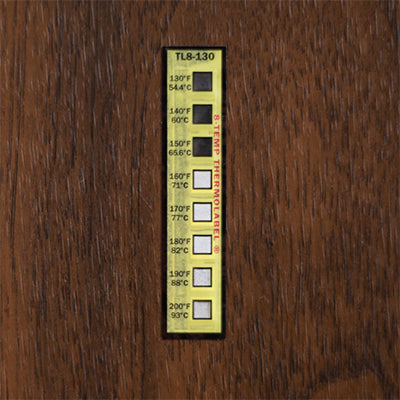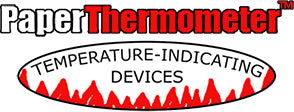Who uses Paper Thermometer temperature labels?
Did you know that a company making printing ink with tiny LED lights suspended in it uses Thermolabel temperature labels? Or that Thermopaper is indispensable in the field of art conservation? What about that our temperature labels are used by countless manufacturers every day in making blister packs for product packaging? Let's explore some of the most common applications for temperature labels.
Metal Coating
For decades the metal coating industry has recognized the benefit of using a temperature label to verify that the metal running through their coating line is at the right temperature to cure properly. Also commonly referred to as coil coating, metal coating is a process critical to much of the metal used in construction (roofing, walls, trim) and automotive applications as well as the metal that goes into producing equipment and consumer goods such as clothing washers and dryers. The use of precoated metal streamlines production and lowers costs. The term coil coating comes from the large rolls or “coils” of sheet metal that are run on a coating line. A coating is applied to the metal's surface which is then heated to cure it before being cooled and rolled back up. This coated metal will then go on to be used in the manufacture of a wide variety of products. Without temperature labels, the coatings on these metals could fail prematurely from improper curing temperature. A Thermolabel temperature label makes inexpensive insurance against costly coating failure.
Dishwasher Sanitation
Temperature labels are a critical component of the food safety effort of any food service operation using hot water sanitation dishwashers (the most common commercial dishwasher). Along with restaurants this includes other food service locations like schools, hospitals and prisons. Any place that food is prepared or served has a need for temperature labels to verify that the dishware and food prep wares are properly sanitized. Failure to effectively sanitize can lead to the spread of dangerous food borne bacteria like E. coli, Staph and Listeria. The solution is to follow FDA Food Code guidelines and always sanitize dishware to a surface temperature of 160F. Regularly checking this with Thermolabel temperature labels keeps people safe.
Wood Products Manufacturing

Temperature labels are used in the production of many items that are made from wood today such as cabinets, doors and furniture. Temperature labels are primarily used in the application of laminations to manufactured wood substrates such as particle board and MDF. There are many different methods for overlay and veneer application. Vacuum and membrane pressing both use heat in forming and bonding laminates to the wood core material. Heating needs to be uniform, whether it is heat applied via radiant heat (curing oven) or by platens. In methods that use platens, the top and bottom platen need to be at the same temperature for a quality result. Temperature labels are used to ensure the required temperature has been reached. Typically, multiple temperature labels are applied to different areas of the surface to verify that the heating is consistent. Modern 3D laminations have opened up nearly endless possibilities for durable and decorative surface finishes on cabinets, doors and furniture. Thermolabel temperature labels have been adopted by many wood products manufacturers and are considered a critical tool for achieving consistent quality results with modern lamination systems.
Food Manufacturing
Temperature labels are used in many food and beverage production settings. The most frequently encountered use for temperature labels in producing the food we eat is related to keeping production equipment clean and sanitized. The Clean In Place method or CIP is used to maintain clean and safe food production equipment without the need for disassembly when cleaning. The interior surfaces of transfer lines, storage tanks, mixers and filling equipment are regularly cleaned and sanitized using an automated CIP system. The multi-step process involves alternating cleaner, sanitizer and fresh water to clean, sanitize and rinse the surfaces that food contacts. Temperature labels are used in making certain that the surfaces being cleaned have reached the full temperature needed for the cleaning to be effective. The temperature labels are not simply applied at one point on the food lines. It is typical for temperature labels to be applied at a variety of locations on the food processing equipment. Placement often includes points that are the longest distance from the CIP equipment because the temperature of the cleaning solution will drop as it gets farther away from its source. Putting temperature labels at the furthest point in the food processing system ensures that the entirety of the equipment has been cleaned correctly.
Screen Printing
Temperature labels like Paper Thermometer's TL5-5C and TL8-330C are essential tools in the screenprinter's toolbox. Conveyor dryer and heat press platens each need their temperature adjusted and set correctly to get a proper cure of the print. If the temperature is not correct and the cure is not complete the garment can be ruined. Poor curing can lead to garments with prints that crack after only a few washes. Some fabrics like polyester and performance fabrics use an ink with a lower curing temperature. There are special temperature labels for this material featuring a lower temperature range than used with typical plastisol ink.
These of course are just a small selection of the different uses for Paper Thermometer temperature labels. It seems like almost every day a new customer with a unique application places an order for Thermolabel temperature labels. Our products are adaptable to just about any use that requires monitoring that a temperature has been reach or making sure that a temperature has not been reached.
If you need help selecting the right temperature label for your application, please contact us and we will be happy to help.
